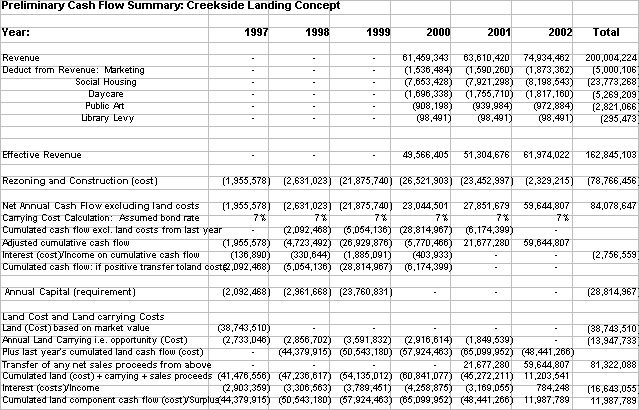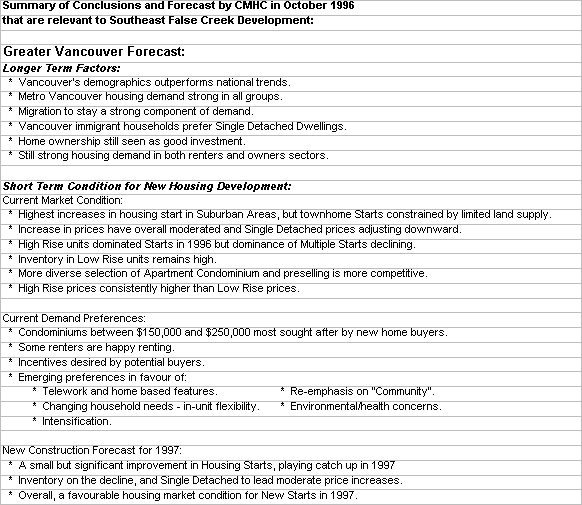

|
Uncertainties
This section discusses the degree of uncertainties in respect of a development of the Southeast Shore of False Creek, based on the Creekside Landing concept. Please note that the cost estimates quoted are order of magnitude, and detailed design will be required to enable more reliable cost estimates to be produced.
Cash Flow and Capital Requirement
A substantial expenditure will have to be made before revenue can be generated. A summary of the projected expenditures and capital requirement is as follows:
Table 11: Cash Flow and Capital Requirement for Creekside Landing

The above estimated cash flow is preliminary. Assuming no debt and no mortgage payment on the land asset, the City can choice to defer the payment for carrying costs and interest costs on the land until a surplus is produced from sale proceeds, probably at the end of the development time frame. This approach, although delays the recovery of land costs, would reduce the project capital requirement, as spending will be made on construction only as opposed to both construction and land costs.
In this scenario, the capital requirement would likely be between $30 and $60 Million, mainly for the years 1999 and 2000 when construction is estimated to happen. Even though revenues are projected for the year 2000, taking a prudent position, it is possible that the revenue could come in at the end of the year; therefore may require capital funding for the year’s construction.
If the development should hit a recession at the time of selling/leasing in the years 2000 to 2002 and the City chooses to to not sell in a down market and wait for an up-turn, $30 Million more may be required, amounting to a total capital requirement of nearly $90 Million.
Significant Funding Commitment
Given the above discussed capital requirements, the City should be prepared to commit to significant funding, in the event that a decision is made to proceed with planning and development of the Creekside Landing concept, as recommended in this report.
During the next two years, i.e. 1997 and 1998, the planning and rezoning costs would be in the order of $2.5 Million. Even if the development is postponed after the rezoning, the spending is considered an investment and a worthwhile expenditure, as a planned and zoned site would increase the land value.
Once construction is in progress to provide new roads, street car right of way, utilities, services, and public amenities, it will be difficult to halt the development; a possibility might be at the end of a development phase. Furthermore, once costs are sunk, they can only be paid back by selling or long-term lease revenues upon completion of the development.
Market Condition
Market condition can change over time, and if an unfavourable market condition should occur after the development costs have been sunk, financial loss is possible. If on the other hand, demand should increase at the time when selling or long-term leasing, a profit can be possible.
Market demand is affected by demographics, migration, supply and demand of competing real estate and the health of the economy. However, market demand in the Lower Mainland is also influenced by immigration and foreign investments. In the case of Southeast False Creek, its longer development time frame creates a wider window for demand change in the future.
In addition to the Consultant’s market study, the conclusion and forecast of a detailed study published by Canada Mortgage and Housing Corporation in October 1996 is summarized as follows:
Table 12: Current Market Condition Summary

Applying the CMHC information in the context of developing Sourtheast False Creek, the long term outlook is expected to be strong demand due to migration and demographics. The 1996 market performance had some disappointment but is expected to improve in 1997. The study sends a signal of shifting demand, in identifying a diverse selection of apartment condominiums, more competitive pre-selling and a declining dominance of multiple housing starts. However, overall new housing inventory is declining which leads to in general, a favourable 1997 forecast for new housing starts.
In a broader context, please recall that the latest real estate up-cycle affected Vancouver in 1988/89, when market prices increased considerably over a short time period until 1990, when a national recession commenced. By the latter part of 1990, while Central Canada continued on the path of a downward slide in real estate demand and prices, Vancouver, due mainly to increasing population, recovered and began another wave of price increase which by the end of 1991, had regained all the price reduction of 1990. The years 1992 to 1995 saw robust demand as well as steady price increases. In 1996, the market declined somewhat both in volume and price, but is expected to improve in 1997.
The latest real estate up-cycle for Vancouver has a run of over eight years now since 1988, and if the future follows the past, in terms of cyclical pattern, the uncertainty of a next down turn could become closer. However, this factor has become more difficult to assess for Vancouver which has been, and may continue to be influenced by migration and demographic change.
A Favourable Scenario
If the current low interest rate environment should continue for the next six to ten years and real estate demand and land prices should increase, the cash flow at completion of the development could increase to nearly $18 to $23 Million, or an IRR of 5% to 6%.
The scenario analysis economic proforma for this scenario is included on the next page as Table 13.
An Unfavourable Scenario
If after physical development has been carried out, an unfavourable market condition should develop at the time of selling the developed parcels, the City may choose to hold the parcels for a market upturn.
Even in the event of a downturn, needed housing supply, public amenities, roads, infrastructure and other objectives will be achieved. When compared with the no development scenario, the Creekside Landing concept would still be better for the City. Furthermore, the City may have a choice to wait and not sell at the trough of the market. Assuming that the new zoning and sites servicing are in place at that time, the City would be well positioned to take advantage of the next market upturn.
Therefore, the down-side uncertainty is considered acceptable in the circumstance.
Table 13: Scenario Analysis for Creekside Landing
![[City Homepage]](/graphics/footnava.gif)
|
![[Get In Touch]](/graphics/footnavb.gif)
|

|

|

|
Last modified: April 8, 1997
(c) 1997 City of Vancouver